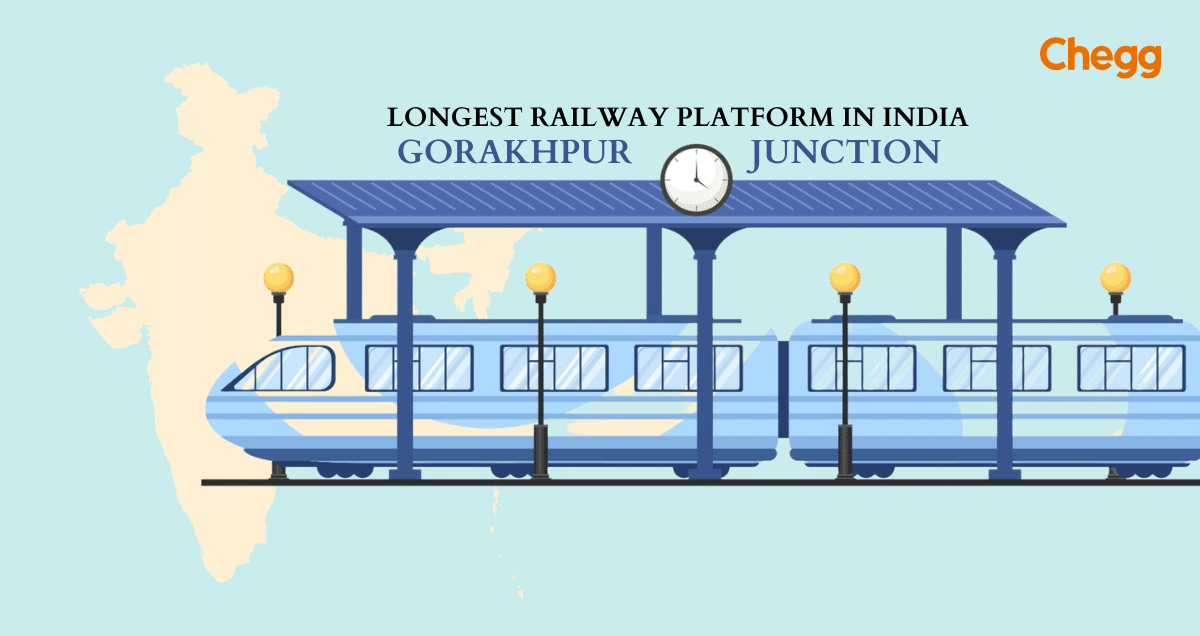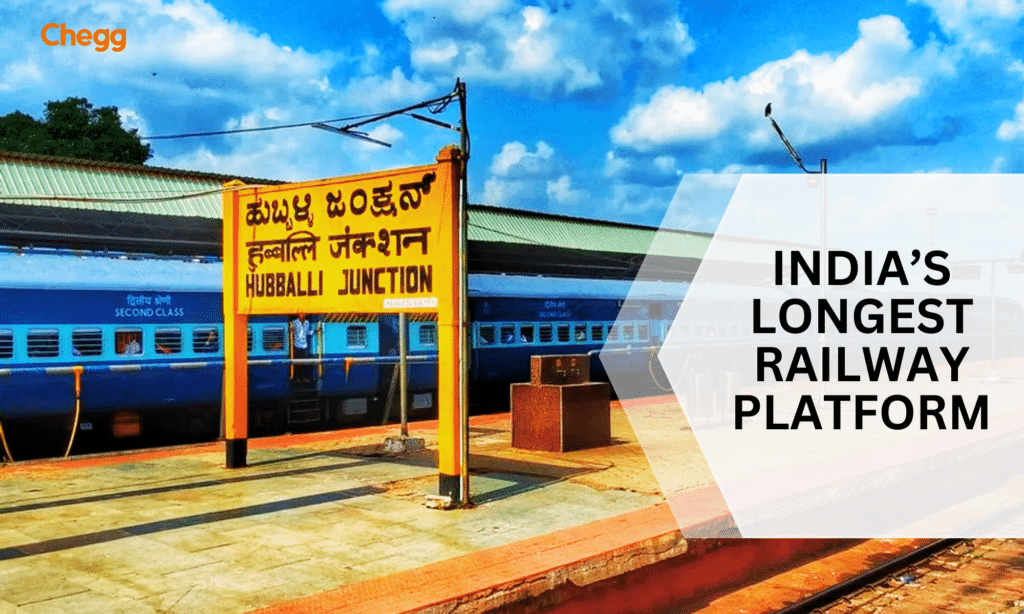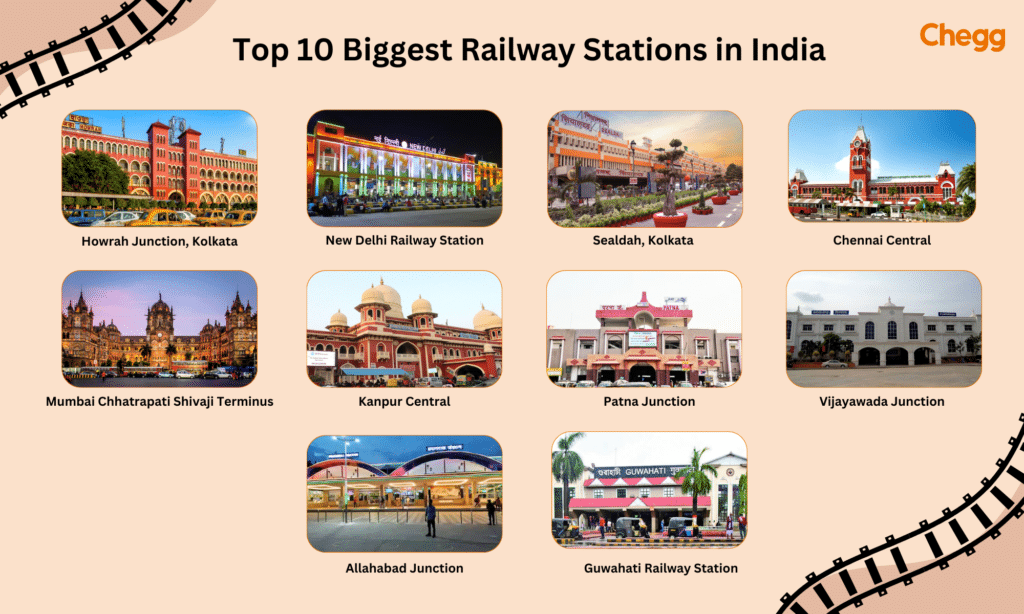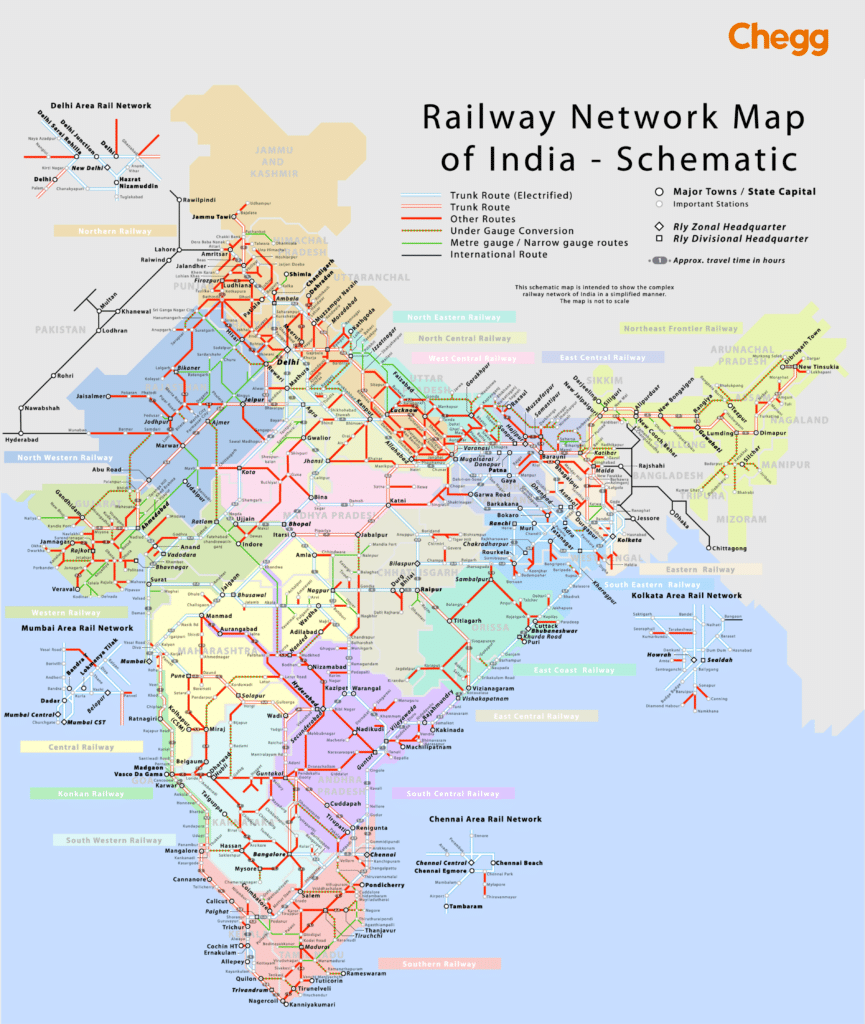Home » General Knowledge » Longest Railway Platform in India: Understanding the Lengthiest
Longest Railway Platform in India: Understanding the Lengthiest

Table of Contents
India’s railway system shows both its rich past and its forward-thinking aspirations. India’s railway network stretches across enormous landscapes. It is a lifeline for countless people, connecting remote towns to busy cities and facilitating the flow of products and passengers with unprecedented efficiency. This introduction sets the stage for a study of longest railway platform in India and its amazing railway infrastructure, emphasising the critical role of railway stations in this complicated transportation web. They are a hive of activity where cultures collide, stories emerge, and journeys begin or end. This article will look at different aspects of India’s railway infrastructure, including its majestic stations, enormous track network, modernization projects, and the country’s social and economic impact. We will explore the intriguing world of Indian railways, from famous intersections to technical breakthroughs, highlighting its significance as a symbol of India’s prosperity and interconnectedness.
What is a Railway Platform?
This platform is the bridge between you and your train journey! It provides a safe and convenient space for passengers to wait, board, and disembark from trains. Larger stations might have several platforms to accommodate the hustle and bustle of many trains arriving and departing. Some platforms even offer amenities like waiting areas, restrooms, and even staff cabins to help you with your travels.
India’s Longest Railway Platform
India has the longest railway platform in the world. This part delves into the extraordinary background behind this engineering masterpiece in a country where trains are extremely important. This largest platform in India, located in Hubballi, Karnataka, reaches an incredible 1,500 metres in length. The Sri Siddharoodha Railway Station proudly hosts this architectural marvel, and its sheer scale represents the breadth of India’s rail network. The importance of this biggest platform in India extends beyond its length, as it is critical to the proper operation of the South Railway Zone, which connects key cities and areas. This platform can accommodate many trains at the same time, alleviating congestion and maintaining smooth passenger movement. India’s longest railway station exemplifies the nation’s commitment to development and unwavering dedication to delivering effective transportation solutions to its huge population.

Hubballi Makes History with Record-Breaking Railway Platform
Hubballi, India, is about to gain global recognition for its newly extended railway platform! Prime Minister Narendra Modi dedicated the impressive 1.5-kilometer (1,507 meters) platform at the Siddharoodha Swamiji Railway Station.
This feat of engineering is not only claimed to be the longest railway platform in India, but also potentially the world’s longest. The SWR Hubballi railway division is understandably proud of this achievement, and the dedication ceremony promises to be a momentous occasion.
History and Evolution of Indian Railway Stations
The history of Indian railway stations is a riveting journey reflecting the country’s evolution. India’s railway network began with the Bombay-Thane line in 1853. Early stations, like the one in Boree Bunder (now Chhatrapati Shivaji Terminus), were small in dimensions and design, reflecting the railway’s infancy. They progressed from being only transit hubs to thriving commercial and cultural hubs. The vast edifices of railway stations, like Kolkata’s Howrah Station and Mumbai’s Victoria Terminus, are architectural wonders of the colonial era. These stations became renowned icons, integrating Victorian, Gothic, and Mughal architectural styles and demonstrating India’s cultural amalgamation.
Indian railway stations have witnessed amazing transformations in the modern period.
Modern stations like Delhi’s Indira Gandhi International Airport Railway Station and Chennai Central have cutting-edge amenities that exemplify modernism and efficiency. The history and growth of Indian railway stations reflect architectural excellence and technological advancements. These stations continue to play an important role in connecting India’s regions and highlighting the country’s rich history and vibrant present.
The Largest Railway Station in India
India’s railway network is home to numerous major landmarks, the largest of which is Howrah Junction, located in Kolkata, West Bengal. This biggest railway station in India shows India’s amazing train infrastructure. Howrah Junction is a bustling travel hub that spans 23 biggest platforms in India and covers a large area. Its massive size accommodates a large number of passengers every day. It also houses various bookstalls, shops, and other businesses, creating a lively atmosphere within its walls.
Howrah Junction is critical in connecting India’s eastern and northeastern areas. It is an important connection in the country’s rail network, allowing for the flow of people and goods. Its importance extends beyond its physical dimensions; it reflects the idea of connectedness and serves as a gateway to the country’s eastern region.
Hubballi Makes History with Record-Breaking Railway Platform
Hubballi, India, is about to gain global recognition for its newly extended railway platform! Prime Minister Narendra Modi is scheduled to dedicate the impressive 1.5-kilometer (1,507 meters) platform at the Siddharoodha Swamiji Railway Station on Sunday.
This feat of engineering is not only claimed to be the longest railway platform in India, but also potentially the world’s longest. The SWR Hubballi railway division is understandably proud of this achievement, and the dedication ceremony promises to be a momentous occasion.
The Busiest Railway Station in India
India’s railway network hums with activity, with New Delhi Railway Station, the busiest station in the country, at its heart. This thriving transit hub demonstrates the scope and vitality of India’s rail infrastructure. Every day at New Delhi Railway Station is a moving symphony. The station is open 24 hours a day, with several trains departing and arriving to link travellers to various parts of India. Numerous persons, from platform sellers to station employees,
contribute to the smooth operation of this busy station. The effort of managing the large number of passengers and trains is Herculean. Advanced scheduling systems, effective crowd control, and contemporary facilities improve the station’s flawless operation.
Exploring the Length of the Longest Platform
Exploring the longest railway platform in India at Sri Siddharoodha Railway Station is an unforgettable experience. Its incredible length of 1.5 km distinguishes it as a tremendous engineering accomplishment. The construction of such a large platform necessitates meticulous planning and execution. It was built with a strong foundation, modern materials, and exquisite artistry.
The platform’s length accommodates numerous trains simultaneously, allowing for quick boarding and disembarking. The longest platform in India at Hubballi stands on the global stage. While it is not the world’s longest, it is among the top platforms globally. This largest platform in India demonstrates India’s engineering expertise and dedication to offering world-class railway facilities to its residents.
Notable Features and Facilities
Over the years, Indian railway stations have seen extraordinary transformations, offering a variety of distinctive amenities and services to enhance passenger experiences. Modern Indian railway stations include wide and well-maintained waiting halls, providing travellers comfort and convenience. To ensure inclusivity, accessibility measures such as ramps, lifts, and specific spaces for travellers with disabilities have been implemented.
Modernization efforts include:
- Wi-Fi connectivity.
- Real-time train tracking systems.
- User-friendly apps for ticket buying and information.
These elements highlight India’s commitment to increasing passenger comfort and making rail travel more accessible and enjoyable. Indian railway stations are becoming more than just transit hubs but also multifunctional centres of comfort and efficiency.
Top 10 Biggest Railway Stations in India
Significant railway stations are vital transportation centres on India’s large railway network. This section will look at the top 10 biggest railway stations in India, each with a geographical significance and various passenger services.

- Howrah Junction, Kolkata – The gateway to Eastern India, noted for its great architecture and cultural significance.
- New Delhi Railway Station – The nation’s capital centre, with contemporary amenities and a comprehensive network.
- Sealdah, Kolkata – A vital station that connects Kolkata to the rest of West Bengal.
- Chennai Central – The significant station in South India, noted for its legacy and connectivity.
- Mumbai Chhatrapati Shivaji Terminus – A UNESCO World Heritage landmark that connects Mumbai to the central and southern areas.
- Kanpur Central – A key North Indian hub for train connections nationwide.
- Patna Junction – Bihar’s gateway allows travel within the state and beyond.
- Vijayawada Junction – A vital South Indian station that connects the region to the rest of the country.
- Allahabad Junction – A vital halt for pilgrims on their way to Prayagraj (formerly Allahabad).
- Guwahati Railway Station – The main station in Northeast India connects the region to the rest of the country.
India’s Biggest Railway Junction
The longest platform in India owes much of its efficiency and connectedness to its numerous railway junctions. Among these, Itarsi Junction is the largest railway station in India. Junctions, which serve as meeting points for trains travelling from various areas and directions, are the lifeblood of the biggest railway junction in India. They provide smooth transfers and connectivity, allowing passengers and cargo to arrive at their destinations on time. Itarsi junctions are the biggest railway junctions in India that allow India’s enormous rail network to function as a whole. Every day, stories of swift train transfers and connectivity come to life at Itarsi Junction. Travellers begin on cross-country journeys, easily shifting between trains travelling in different directions.
Also Read :-
Longest National Highway in India: Learn More About It
World highest railway bridge | Chenab Bridge
The Longest Train Route in India: Explore the Journey
Future Developments and Expansion Plans
With ambitious expansion projects, technology developments, and sustainability measures on the horizon, Indian railway stations are prepared for a dynamic future. These advancements portend a brighter, more efficient, and environmentally responsible future for India’s rail network. Major railway stations are being expanded to meet rising passenger demand. Infrastructure and passenger comfort are being improved through station rehabilitation projects and new terminals. High-speed trains, predictive maintenance, and digital ticketing systems are transforming the railway scene, providing passengers with increased convenience and efficiency. The Indian Railways is devoted to sustainability, with plans for route electrification, solar power installations, and eco-friendly station designs in the works. A modern, sustainable, and well-connected rail infrastructure will propel India forward.
Railway Safety and Security
Safety and security are paramount due to the large number of passengers and precious assets in transit on India’s massive railway network. Security measures at Indian railway stations include surveillance cameras, luggage scanners, and people trained to recognize and respond to security threats. To protect travellers, enhanced access control and ticket inspections are standard practices. Indian Railways has put in place effective emergency response and disaster management systems. Rapid reaction teams, medical facilities, and evacuation protocols are in place to manage accidents and crises. Furthermore, regular safety drills and training programs guarantee that railway personnel are well-prepared in a disaster.
Conclusion: India’s Impressive Railway Infrastructure
In conclusion, the biggest railway stations in India are gigantic symbols of the country’s amazing railway infrastructure. These hubs, which range from booming metropolises to isolated junctions, are critical in uniting a huge and diverse country like India. The splendor of these stations, whether through architectural splendour or technological innovation, attests to India’s unwavering pursuit of advancement. They are more than just transportation hubs; they are living histories of India’s history, culture, and connectedness. These railway stations provide a one-of-a-kind invitation to discover India’s essence. Each station tells a story, welcomes travellers, and urges them to embark on adventures of discovery, from the vitality of New Delhi Railway Station to the timeless beauty of Chennai Central.

Frequently Asked Questions ( FAQ’s )
With approximately 67,000 kilometres of track and dozens of railway stations connecting nearly every area of the country, India has one of the world’s most comprehensive railway networks.
Millions of passengers and trains travel through New Delhi Railway Station daily, making it the busiest railway station in India.
Indian Railways is actively modernising through high-speed train projects, route electrification, modern signalling systems, and adopting eco-friendly practices to cut carbon emissions.
The safety procedures include regular inspections, maintenance, and crisis management training for railway staff. Station security measures include CCTV surveillance, baggage check, and attentive staff.
Located in the heart of the Indian capital, New Delhi Railway Station serves as a prominent transportation hub.
Gorakhpur Junction railway station, situated in the city of Gorakhpur, Uttar Pradesh, holds the title for having the world’s second longest railway platform, following Hubballi Junction railway station in Karnataka. It functions as the headquarters of the North Eastern Railway, a division of Indian Railways.
Got a question on this topic?